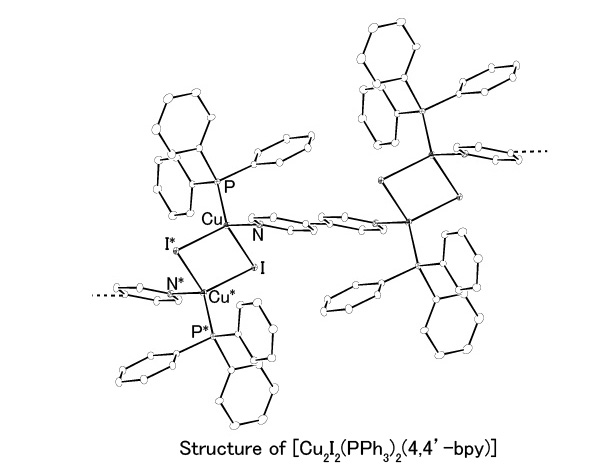00338
Photo excited state crystallography iodo-bridged dicopper (I) complex.
Graduate School of Material Science, University of Hyogo* Japan Synchrotron Radiation Reseach Institute** Graduate School of Science, Hokkaido University, Japan***
○Shingo Yoshida* Yoshiki Ozawa* Minoru Mitsumi* Koshiro Toriumi* Nobuhiro Yasuda** Kiyoshi Tsuge*** Hiromi Araki*** Yoichi Sasaki***
A luminescent dicopper(I) complex [Cu2I2(PPh3)2(4,4'-bpy)]∞ (bpy=C10H8N2) consists of {Cu2I2} planer units, which are bridged by diimine ligands constructing an infinite chain structure. The assignments of emission bands of the oligo-copper compounds are complicated because the weak interacted multi-copper centered charge transfer is often concurrent with the common Cu(I) to ligand charge transfer. We've tried to observe geometrical distortion in the excited state of the complex by crystallographic technique in order to figure out this emission nature.
Single crystal X-ray diffraction experiments were performed by using the low-temperature vacuum X-ray camera at SPring-8 BL02B1 beamline. Full intensity data of both under light irradiated and non-irradiated conditions were collected by multiple-exposure method. Two CW laser light, 442nm on the absorption band and 532nm on its tail, were used. Photo-difference Fourier syntheses for the 442nm irradiation show that a small portion of two I atoms in {Cu2I2} unit shift toward close to each other, while two Cu atoms tend to shift apart from each other. No significant peak was observed for the 532nm case.
[1] Tsuge et al., Inorg. Chem., 2005, 44, 9667. [2] Ozawa Y et al., Chem. Lett., 2003, 32, 62.

